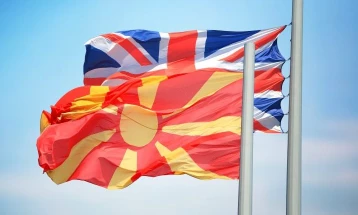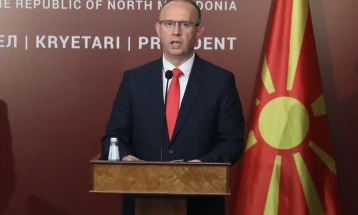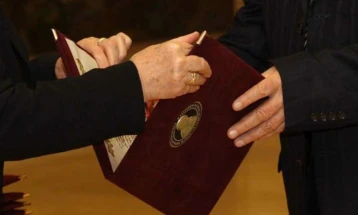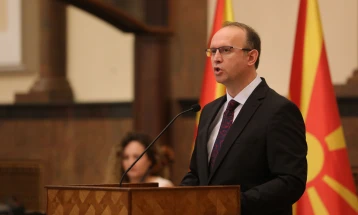Rozeva Baumgartner, art medal maker: Culture unites, it is there to show us we can be a better version of ourselves
- Medal is an art for the hand, an art form that has existed for a very long time. It’s connected to the coins, and this is where the inspiration comes from. This is kind of synthesis of your ideas on small surface by visually aesthetic means. That is the challenge – to get rid of the unnecessary detail and create something that is recognizable, that will stay and express clearly an idea, said Nadia Rozeva Baumgartner in an interview with MIA, revealing the secrets of the creating art medal.
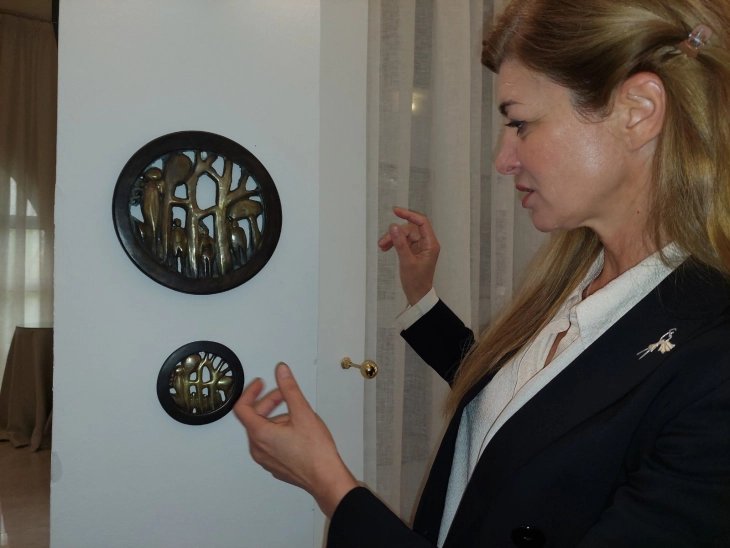
Skopje, 29 October 2023 (MIA) - Medal is an art for the hand, an art form that has existed for a very long time. It’s connected to the coins, and this is where the inspiration comes from. This is kind of synthesis of your ideas on small surface by visually aesthetic means. That is the challenge – to get rid of the unnecessary detail and create something that is recognizable, that will stay and express clearly an idea, said Nadia Rozeva Baumgartner in an interview with MIA, revealing the secrets of the creating art medal.
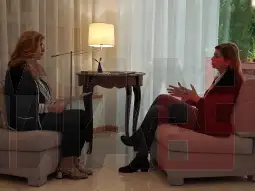
This was an art form that was highly connected to the Middle Ages. The first artist who created realistic portraits on medals was Pisanello, who worked in the 15th century and who is considered one of the fathers of the art medal. The main challenge, she said, in this art form is to create a visually appealing image of two sides that are connected, sometimes a vision and a consequence, or an idea that gets further developed on the opposite side, obverse and reverse, or to express an idea on a very small circles. This is kind of synthesis of your ideas on small surface by visually aesthetic means. That is the challenge – to get rid of the unnecessary detail and create something that is recognizable, that will stay and express clearly an idea.
Art is not just talent, Rozeva Baumgartner said, art is a very good knowledge of history, of different events, biblical subjects, antique culture because all the artists took their inspiration from antiquity.
“So the eternal themes of Adam and Eve, man and wife, good and evil. In order to be interesting as an artist you have to have good knowledge of those subjects, to present them in your own way, because we do not create new things, but we tell them in our own way. In order to make medals, you need to experiment a lot and fail a lot. I have probably over 300 works now, of which I would exhibit maybe one-third of them. It is interesting to see how we also do self-censorship, how we know when to stop when working on a certain work, how to not make it worse, to have the limits,” Rozeva Baumgartner added.

She said that there are quite a few private collectors and that is great because it is a way to keep the inspiration but also to sell work which is also important for a freelance artist, but also to have works in private collections because this is appreciation of your work, so there is feedback.
“Because as artists, we can get very lonely in our studios if there is no one to buy your work. I have private collectors in Japan, I have exhibited three times in Japan at the invitation of different galleries, and have 15 works there, and in other countries as well,” she said.
In art medals in general, 20 works are considered to be original so every time you cast a work I always experiment with patina, because I apply my own patina, she noted.

“So as you see, this is really art for the hand, the final touches are made by polishing with the hand, the grease of the hand stays on the patina and makes it shiny,” Rozeva Baumgartner explained.
“I am very happy that I was invited by the National Gallery to show my works in North Macedonia. From what I hear, this is going to be the first exhibition of this kind in the country. For me, it is very important because one of my missions is to popularize the genre of the medal, and I would also like to hold workshops with young artists or anyone who is interested to see the process of creating medals in order to maybe spark interest among artists here to start working on this genre but also to become members of the International Art Medal Federation and maybe at the next congress in Munich we could also have some Macedonian artists,” she noted.

Nadia is the wife of French Ambassador Cyrille Baumgartner and has been living in the country for two years, and the first thing she does when she visits a country is to acquaint herself with the cultural situation, the artists, the state of the arts.

“I find it very interesting and enriching to be able to visit many concerts, my husband and I are very frequent visitors of Philharmonic concerts, Ohrid Summer, I follow the country’s art scene, visual arts, music, follow the work of the National Gallery and the most impressive collection “Solidarity” in the Museum of Contemporary Arts, which is also travelling in Vienna, the Czech Republic next year and is a real treasure. I am discovering new artists, classical Macedonian artists who have already become established names and who are not amongst the living, like Chemerski, Andreevski, Manev, Lazeski, Lichenoski etc. It is very interesting to see that artists here don’t have it easy but try to really change and go forward and also try to be part of a thriving cultural European and international scene,” Rozeva said.
“A lot has been done in the sphere of culture, I follow the work of Minister of Culture Bisera Kostadinovska Stojchevska I congratulate Skopje for being chosen as European Capital of Culture in 2028, this is a very big achievement and a big step forward to be able to change things, and a chance to transform the city and do a lot of great things for it, for artists to get mobilized and show their best to prepare for this incredible opportunity,” she said.

She also designs jewellery. Creating jewellery is more fun, designer creations are easy to sell, and at the same time carry your own unique stamp. Her creation is also the "Superwoman" broach, made and promoted as a trademark of the Bulgarian edition of Forbes magazine, which ranks successful women entrepreneurs.
“I have always wanted to expand, and I have always stayed in the sphere of culture, be it book publishing, marketing director of the philharmonic orchestra, so the cultural processes have always been very much part of my background. I’ve been manager of a gallery, I’ve done the largest art expo in Bulgaria during the pandemic when 100 artists exhibited their works under the same space. Cultural diplomacy is an interesting field that I really want to explore to solve problems that cannot be solved in other ways. This is what makes people really come together. We speak the same language even though we speak very different languages. Culture unites, culture should stay out of politics. I have seen so many colleagues from all over the world – New Zealand, Japan, Central America, almost all European countries, United States, Canada – even if they didn’t speak English or the same language, we got along perfectly fine because we could understand the common language of art. Art is there to show us we can be a better version of ourselves, to look for the beautiful things and to look for harmony,” Nadia Rozeva Baumgartner said in an interview with MIA.
Violeta Gerov
Photo/Video: Aslan Vishko

